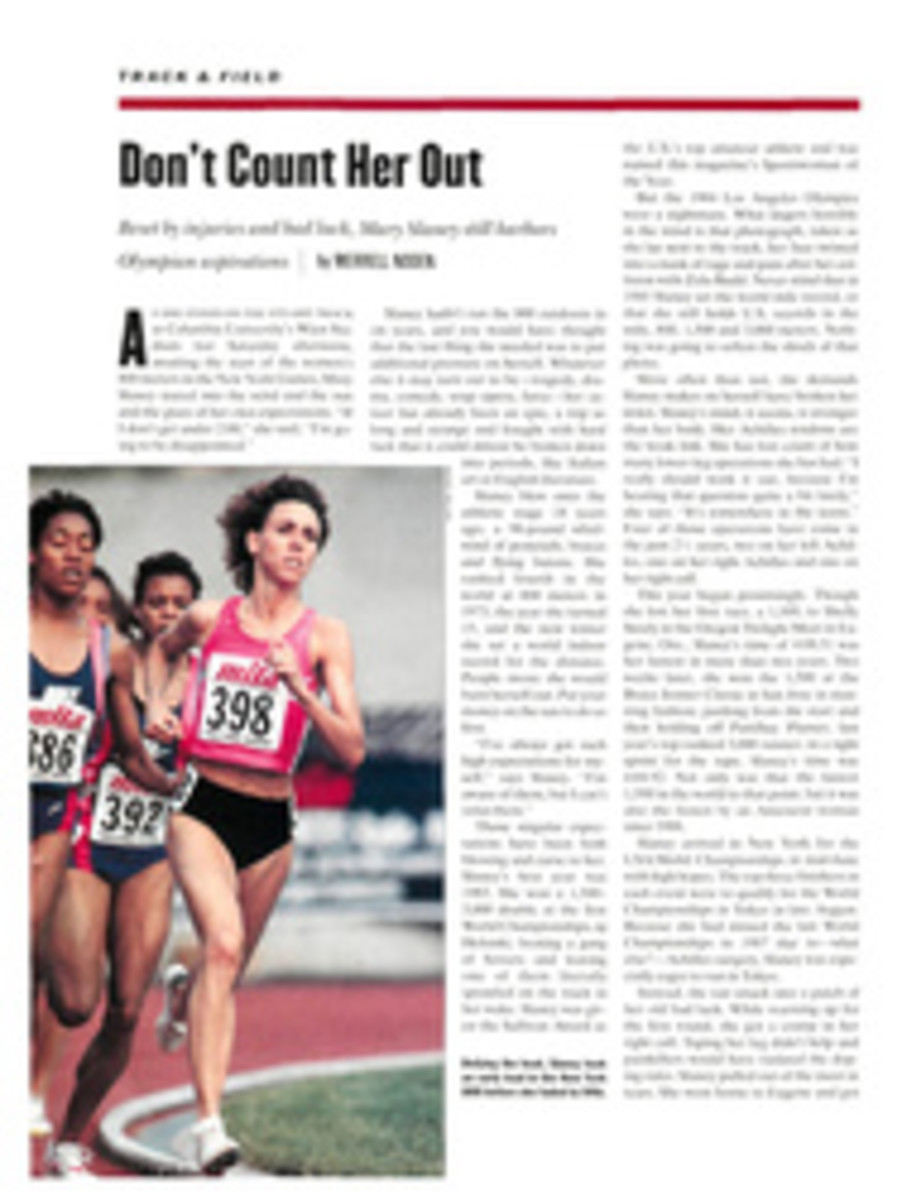
Truth or Where?
When Monica Seles got ready for her close-up, it all became too much. The phalanx of cameras, which did nothing to disabuse Seles of the notion that she was the portrait of a young starlet, was a little much. The T-shirt she held up that read ROME, PARIS, WIMBLEDON, MAHWAH—but with the Wimbledon crossed out—was definitely too much. Seles herself was really too much, batting her eyes, cradling an expensive little dog in her arm and affecting a breathy voice—you expected her to call you "dahling" at any moment—until you didn't know which she deserved more, a screen test or a cream pie in the face.
Is this the part where we learn that Seles, the No. 1 women's tennis player in the world, has a past? That in another life she had been married to a gas station pump boy and lived above a diner? That her angora sweater had caught the eye of a major producer as he leafed through a magazine at the drugstore counter where she was enjoying a malt? That her real name was Edwina Kerchinsky, waitress? Cut. When Seles, the self-styled mystery woman and wannabe star of stage and screen, resurfaced in a blaze of publicity last week, 27 days after withdrawing from Wimbledon and disappearing from public view without explanation, it was difficult to remember that she was nothing more than a 17-year-old truant suffering from shin splints.
In what was the silliest performance of the year by a major athlete, Seles ended nearly a month of wild innuendo as to her health—she wasn't pregnant, as a London tabloid had speculated—and whereabouts with a three-ring press conference last Thursday before her participation in an exhibition tournament in Mahwah, N.J. During an unwittingly hilarious 30-minute question-and-answer session, Seles alternately hedged, backed and filled, posed and primped, and contradicted herself. All that was clear was that Seles had withdrawn from Wimbledon with a case of shin splints and a stress fracture in her left leg, and that she had been treated by orthopedic specialist Dr. Richard Steadman of Vail, Colo.
Is Seles just a hurt kid who wanted to get away from it all? Or is she a savvy publicity prankster who, amid the Wimbledon flap, staged a photo (page 2) in which she wore a wig—her father, Karolj, had one on too—as she stepped out of a white limo, a la her role model, Madonna?
But though Seles may have created this entire melodrama to emulate Madonna (Truth or Where?), it came out like Zsa Zsa Gabor. Or Milli Vanilli. While no one would dispute that Seles was genuinely injured, there was some evidence to suggest that her intriguing silence and subsequent grand entrance at Mahwah had been orchestrated. She had even rehearsed the night before the press conference with a publicist and a tape recorder. "The best part is that now I can walk down the street without a disguise," she said, dramatically. John Korff, the tournament director of the Pathmark Tennis Classic at Mahwah, a likable if shameless huckster, called the Seles press conference "the biggest thing in women's tennis since King versus Riggs." Seles's brother and manager, Zoltan, a curious 26-year-old with a habit of lunging into the corners of photos uninvited, proclaimed it "great for tennis and great for Monica. This is glamorous."
But some facets of the Seles affair were neither glamorous nor comical. Seles gave no clear explanation or apology for her lack of response to repeated inquiries from Women's Tennis Association executive director Gerard Smith, Wimbledon referee Alan Mills and her own representatives at International Management Group. All of them had doggedly requested throughout the Wimbledon fortnight that she clarify her statement, issued just 72 hours before the start of the tournament, that a "minor accident" had caused her to withdraw. And all were greatly embarrassed by her unwavering refusal to reply. In Mahwah, Seles said, "I needed my time alone," and added that even as the tennis world was abuzz over her inexplicable disappearance, she had been unaware of the controversy. If Seles was so unaware of the storm she was creating, why did she feel compelled to go about disguised in a wig?
Seles said the chief reason she did not clarify her statement concerning Wimbledon was that she had received at least four different diagnoses of her injury. "I myself was totally confused," she said. "The most important thing was to know that I could come back and play tennis."
That explanation was good enough for Smith, who finally talked with Seles for about 45 minutes two days before her press conference. He upheld the $6,000 fine he had levied against her during Wimbledon, gave her a mild lecture on leadership responsibilities and pronounced the matter closed. Yet under rules designed to protect tour events from being stripped of players by lucrative exhibitions, Seles was fined an additional $20,000 for playing in Mahwah, which she will appeal.
Still, it was surely inappropriate for the game's top-ranked player to use an outlaw exhibition—for which she pocketed a $350,000 guarantee—as the occasion for her comeback, while reneging on her commitment to play Federation Cup for Yugoslavia the following week. Seles's appearance at Mahwah, which ended on Sunday with a straight-set loss to Jennifer Capriati, discomforted even the shakers at IMG. The Mahwah deal with Korff was made by Zoltan, not the agency. "[Number One players] have to learn for themselves," Bob Kain, head of IMG's tennis division, said of being in the spotlight. "This is probably a pretty good lesson."
In particular, Seles ought to learn something from the disconcerted reaction of her corporate sponsors, some of whom nervously expressed their concern to IMG during her sabbatical. "They said, 'This isn't good, is it?' " Kain said.
In the end, there was nothing to make of Seles's antics except that she is a most independent and unpredictable star. If Smith was inclined to go easy on Seles, it was probably because she is a lively, intelligent player, one who theretofore had displayed a more developed sense of history and responsibility than most players her age. Also, that Seles would disappear from view was not inconsistent with the kooky persona she has often displayed during her brief career. She had a thing for wearing wigs even before her Wimbledon pullout and a habit of booking early-morning practice courts so no one could watch her working out.
At the same time, Seles shamelessly courts publicity. She has proclaimed her ambition to become an entertainer, once remarking that since she can't sing, "I'll just act." Kain has promised to use his business contacts in Los Angeles on her behalf when she says she is ready to pursue her alternate career. "I hope that waits until at least she has reached voting age," said Kain. Maybe that career has already been launched.
TWO PHOTOS
MANNY MILLAN
This way, Monica! No, over here! The press horde couldn't get enough of tennis's Material Girl, who returned to action after battling shin splints.

